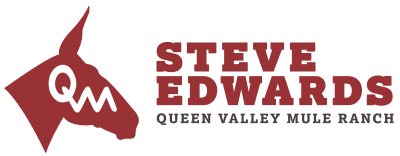Ready to Buy a Mule? What You Should Look For
Steve Edwards: When I look at animals for people I look at conformation. All the time, people ask me what to look for. Well, what to look for is this. You look for disposition first. Disposition, a willing disposition. One that says, “Ah, that’s okay, ah, that’s all right,” and pretty much goes along with everything. The majority of the time, yeah, they’ll get grumpy, like Daisy where she’s kind of wanting to be the top of the pecking order and she’ll be grumpy for a little bit, but disposition.
Second thing I look for is conformation. Now, conformation. If we look and see a little stubby neck, that is hard for an animal to turn with a little stubby neck like that. Can you get it? Yes, you can. Notice how when this mule stands, his neck comes up out of his shoulders. You see that? Notice when this mule stands, his neck comes down out of her shoulders. Do you see the difference? When I’m looking for a trail animal, I’m looking for conformation next, I’m looking for when they walk they walk just like this. Framed up, all ready. Naturally framed up without bridling. Okay? So that’s the next thing I look for.
Next thing I look for then is I look for conformation-wise, look at how straight the legs are. You see how the slope of the shoulder fits the slope of the foot. Real nice. Clean, front end. Nice and straight. Okay? Things I look for is white hairs like this and bumps like this. Some way or another this mule has hit himself on the cannon bone area.
Women: No, no, no, those are just flies.
Steve Edwards: Oh, you got the fly problem? Okay. For flies, take WD-40 in the spring, before the flies start getting them, and spray WD-40 on their legs. It’s not an oil-based, it’s not a petroleum, it’s a fish-base. That oil on there will keep the flies off of it and keep the itching off of it.
Women: How long will it last? Do you have to do it every day?
Steve Edwards: It just depends on the animal. Depends on the dust and that sort of thing. I also put it on their hair on their tails, so when they flip around their tails, it flips the oil onto them, the WD-40.
Okay. The next thing we look at. We look back here in the back legs. This little mule here, whoa, this little mule here has got a really nice heavy gaskin muscle. See this muscle right here?
Man: Yeah.
Steve Edwards: That’s a nice, big, heavy gaskin muscle. But this is Quarter Horse bred. Her type of hip is Quarter, it slopes down. So some type of Quarter Horse is in this little mule.
Now, when you look at this little mule from behind, you see it has a nice rounded hip. Let me move the legs a little bit here. Okay. Now, with them standing, you see how this little mule stands fairly straight. Step. Step. Step. Okay. You see in the back here, notice how the feet flair out toward the front. Right and left. That’s from not being trimmed as a baby. So it’s actually walking like a duck, kind of like this. That, unfortunately, what that does to him, that brings the hock area, which is this area right in here, it brings the hocks close together. All right? Now, watch when I walk this mule how far apart the hocks are. That’s really important, because if he’s got a lot of donkey in him, you’ll see the hocks will come close together and will be brushing each other, which can create problems later on in life.
- Posted in: Everything, Halter Training, Videos
- Tagged: Everything, Halter Training, Videos


